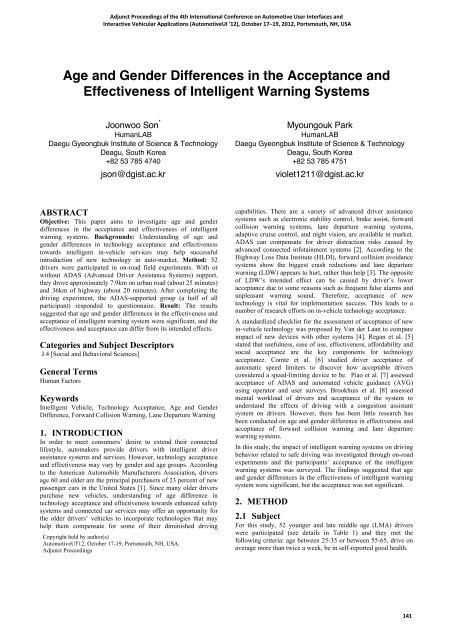12: Adjunct Proceedings - Automotive User Interfaces and ...
12: Adjunct Proceedings - Automotive User Interfaces and ...
12: Adjunct Proceedings - Automotive User Interfaces and ...
Create successful ePaper yourself
Turn your PDF publications into a flip-book with our unique Google optimized e-Paper software.
Age <strong>and</strong> Gender Differences in the Acceptance <strong>and</strong><br />
Effectiveness of Intelligent Warning Systems<br />
Joonwoo Son *<br />
HumanLAB<br />
Daegu Gyeongbuk Institute of Science & Technology<br />
Deagu, South Korea<br />
+82 53 785 4740<br />
json@dgist.ac.kr<br />
ABSTRACT<br />
Objective: This paper aims to investigate age <strong>and</strong> gender<br />
differences in the acceptance <strong>and</strong> effectiveness of intelligent<br />
warning systems. Backgrounds: Underst<strong>and</strong>ing of age <strong>and</strong><br />
gender differences in technology acceptance <strong>and</strong> effectiveness<br />
towards intelligent in-vehicle services may help successful<br />
introduction of new technology in auto-market. Method: 52<br />
drivers were participated in on-road field experiments. With or<br />
without ADAS (Advanced Driver Assistance Systems) support,<br />
they drove approximately 7.9km on urban road (about 25 minutes)<br />
<strong>and</strong> 36km of highway (about 20 minutes). After completing the<br />
driving experiment, the ADAS-supported group (a half of all<br />
participant) responded to questionnaire. Result: The results<br />
suggested that age <strong>and</strong> gender differences in the effectiveness <strong>and</strong><br />
acceptance of intelligent warning system were significant, <strong>and</strong> the<br />
effectiveness <strong>and</strong> acceptance can differ from its intended effects.<br />
Categories <strong>and</strong> Subject Descriptors<br />
J.4 [Social <strong>and</strong> Behavioral Sciences]<br />
General Terms<br />
Human Factors<br />
<strong>Adjunct</strong> <strong>Proceedings</strong> of the 4th International Conference on <strong>Automotive</strong> <strong>User</strong> <strong>Interfaces</strong> <strong>and</strong><br />
Interactive Vehicular Applications (<strong>Automotive</strong>UI '<strong>12</strong>), October 17–19, 20<strong>12</strong>, Portsmouth, NH, USA<br />
Keywords<br />
Intelligent Vehicle, Technology Acceptance, Age <strong>and</strong> Gender<br />
Difference, Forward Collision Warning, Lane Departure Warning<br />
1. INTRODUCTION<br />
In order to meet consumers’ desire to extend their connected<br />
lifestyle, automakers provide drivers with intelligent driver<br />
assistance systems <strong>and</strong> services. However, technology acceptance<br />
<strong>and</strong> effectiveness may vary by gender <strong>and</strong> age groups. According<br />
to the American Automobile Manufacturers Association, drivers<br />
age 60 <strong>and</strong> older are the principal purchasers of 23 percent of new<br />
passenger cars in the United States [1]. Since many older drivers<br />
purchase new vehicles, underst<strong>and</strong>ing of age difference in<br />
technology acceptance <strong>and</strong> effectiveness towards enhanced safety<br />
systems <strong>and</strong> connected car services may offer an opportunity for<br />
the older drivers’ vehicles to incorporate technologies that may<br />
help them compensate for some of their diminished driving<br />
Copyright held by author(s)<br />
<strong>Automotive</strong>UI'<strong>12</strong>, October 17-19, Portsmouth, NH, USA.<br />
<strong>Adjunct</strong> <strong>Proceedings</strong><br />
Myoungouk Park<br />
HumanLAB<br />
Daegu Gyeongbuk Institute of Science & Technology<br />
Deagu, South Korea<br />
+82 53 785 4751<br />
violet<strong>12</strong>11@dgist.ac.kr<br />
capabilities. There are a variety of advanced driver assistance<br />
systems such as electronic stability control, brake assist, forward<br />
collision warning systems, lane departure warning systems,<br />
adaptive cruise control, <strong>and</strong> night vision, are available in market.<br />
ADAS can compensate for driver distraction risks caused by<br />
advanced connected infotainment systems [2]. According to the<br />
Highway Loss Data Institute (HLDI), forward collision avoidance<br />
systems show the biggest crash reductions <strong>and</strong> lane departure<br />
warning (LDW) appears to hurt, rather than help [3]. The opposite<br />
of LDW’s intended effect can be caused by driver’s lower<br />
acceptance due to some reasons such as frequent false alarms <strong>and</strong><br />
unpleasant warning sound. Therefore, acceptance of new<br />
technology is vital for implementation success. This leads to a<br />
number of research efforts on in-vehicle technology acceptance.<br />
A st<strong>and</strong>ardized checklist for the assessment of acceptance of new<br />
in-vehicle technology was proposed by Van der Laan to compare<br />
impact of new devices with other systems [4]. Regan et al. [5]<br />
stated that usefulness, ease of use, effectiveness, affordability <strong>and</strong><br />
social acceptance are the key components for technology<br />
acceptance. Comte et al. [6] studied driver acceptance of<br />
automatic speed limiters to discover how acceptable drivers<br />
considered a speed-limiting device to be. Piao et al. [7] assessed<br />
acceptance of ADAS <strong>and</strong> automated vehicle guidance (AVG)<br />
using operator <strong>and</strong> user surveys. Brookhuis et al. [8] assessed<br />
mental workload of drivers <strong>and</strong> acceptance of the system to<br />
underst<strong>and</strong> the effects of driving with a congestion assistant<br />
system on drivers. However, there has been little research has<br />
been conducted on age <strong>and</strong> gender difference in effectiveness <strong>and</strong><br />
acceptance of forward collision warning <strong>and</strong> lane departure<br />
warning systems.<br />
In this study, the impact of intelligent warning systems on driving<br />
behavior related to safe driving was investigated through on-road<br />
experiments <strong>and</strong> the participants’ acceptance of the intelligent<br />
warning systems was surveyed. The findings suggested that age<br />
<strong>and</strong> gender differences in the effectiveness of intelligent warning<br />
system were significant, but the acceptance was not significant.<br />
2. METHOD<br />
2.1 Subject<br />
For this study, 52 younger <strong>and</strong> late middle age (LMA) drivers<br />
were participated (see details in Table 1) <strong>and</strong> they met the<br />
following criteria: age between 25-35 or between 55-65, drive on<br />
average more than twice a week, be in self-reported good health.<br />
141





